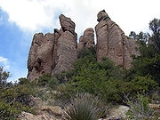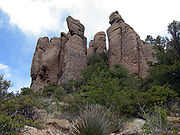
Johann's Pinyon
Encyclopedia

Pine
Pines are trees in the genus Pinus ,in the family Pinaceae. They make up the monotypic subfamily Pinoideae. There are about 115 species of pine, although different authorities accept between 105 and 125 species.-Etymology:...
in the pinyon pine
Pinyon pine
The pinyon pine group grows in the southwestern United States and in Mexico. The trees yield edible pinyon nuts, which were a staple of the Native Americans, and are still widely eaten...
group, native to North America
North America
North America is a continent wholly within the Northern Hemisphere and almost wholly within the Western Hemisphere. It is also considered a northern subcontinent of the Americas...
. The range extends from southeast Arizona
Arizona
Arizona ; is a state located in the southwestern region of the United States. It is also part of the western United States and the mountain west. The capital and largest city is Phoenix...
and southwest New Mexico
New Mexico
New Mexico is a state located in the southwest and western regions of the United States. New Mexico is also usually considered one of the Mountain States. With a population density of 16 per square mile, New Mexico is the sixth-most sparsely inhabited U.S...
, United States
United States
The United States of America is a federal constitutional republic comprising fifty states and a federal district...
, south in Mexico
Mexico
The United Mexican States , commonly known as Mexico , is a federal constitutional republic in North America. It is bordered on the north by the United States; on the south and west by the Pacific Ocean; on the southeast by Guatemala, Belize, and the Caribbean Sea; and on the east by the Gulf of...
along the Sierra Madre Occidental
Sierra Madre Occidental
The Sierra Madre Occidental is a mountain range in western Mexico.-Setting:The range runs north to south, from just south of the Sonora–Arizona border southeast through eastern Sonora, western Chihuahua, Sinaloa, Durango, Zacatecas, Nayarit, Jalisco, Aguascalientes to Guanajuato, where it joins...
and the Sierra Madre Oriental
Sierra Madre Oriental
The Sierra Madre Oriental is a mountain range in northeastern Mexico.-Setting:Spanning the Sierra Madre Oriental runs from Coahuila south through Nuevo León, southwest Tamaulipas, San Luis Potosí, Querétaro, and Hidalgo to northern Puebla, where it joins with the east-west running Eje Volcánico...
to southern Zacatecas
Zacatecas
Zacatecas officially Estado Libre y Soberano de Zacatecas is one of the 31 states which, with the Federal District, comprise the 32 Federal Entities of Mexico. It is divided in 58 municipalities and its capital city is Zacatecas....
and San Luis Potosí. It occurs at moderate to high altitudes, from 1600–3000 m (5,249.3–9,842.5 ft) , in cool, dry climate conditions.
Description
Pinus johannis is a small to medium-size treeTree
A tree is a perennial woody plant. It is most often defined as a woody plant that has many secondary branches supported clear of the ground on a single main stem or trunk with clear apical dominance. A minimum height specification at maturity is cited by some authors, varying from 3 m to...
, often just a shrub
Shrub
A shrub or bush is distinguished from a tree by its multiple stems and shorter height, usually under 5–6 m tall. A large number of plants may become either shrubs or trees, depending on the growing conditions they experience...
, reaching 4–10 m (13.1–32.8 ft) tall and with a trunk diameter of up to 50 cm. The bark is grey-brown, thin and scaly at the base of the trunk. The leaves
Leaf
A leaf is an organ of a vascular plant, as defined in botanical terms, and in particular in plant morphology. Foliage is a mass noun that refers to leaves as a feature of plants....
('needles') are in mixed fascicles of three and four, slender, 3-6 cm long, and deep green to blue-green, with stomata confined to a bright white band on the inner surfaces.
The cones
Conifer cone
A cone is an organ on plants in the division Pinophyta that contains the reproductive structures. The familiar woody cone is the female cone, which produces seeds. The male cones, which produce pollen, are usually herbaceous and much less conspicuous even at full maturity...
are globose, 2-4 cm long and 2-3 cm broad when closed, green at first, ripening yellow-brown when 16-18 months old, with only a small number of thin, fragile scales, typically 6-12 fertile scales. The cones open to 3-5 cm broad when mature, holding the seed
Seed
A seed is a small embryonic plant enclosed in a covering called the seed coat, usually with some stored food. It is the product of the ripened ovule of gymnosperm and angiosperm plants which occurs after fertilization and some growth within the mother plant...
s on the scales after opening. The seeds are 9-12 mm long, with a thick shell, a white endosperm
Endosperm
Endosperm is the tissue produced inside the seeds of most flowering plants around the time of fertilization. It surrounds the embryo and provides nutrition in the form of starch, though it can also contain oils and protein. This makes endosperm an important source of nutrition in human diet...
, and a vestigial 1-2 mm wing; they are dispersed by the Mexican Jay
Mexican Jay
The Mexican Jay, Aphelocoma wollweberi, formerly known as the Gray-breasted Jay, is a New World jay native to the Sierra Madre Oriental, Sierra Madre Occidental, and Central Plateau of Mexico. It reaches north to eastern Arizona, western New Mexico and western Texas in the United States...
, which plucks the seeds out of the open cones. The jay, which uses the seeds as a major food resource, stores many of the seeds for later use; some of these stored seeds are not used and are able to grow into new trees.
History
Johann's Pinyon is a recently described pinyon pinePinyon pine
The pinyon pine group grows in the southwestern United States and in Mexico. The trees yield edible pinyon nuts, which were a staple of the Native Americans, and are still widely eaten...
, discovered by Elbert L. Little in 1968 when comparing pinyons growing in Arizona with those of typical Mexican Pinyon
Mexican Pinyon
The Mexican Pinyon ' is a pine in the pinyon pine group, native to western North America.-Distribution:The range extends from westernmost Texas, United States , south through much of Mexico, occurring widely along the Sierra Madre Oriental and Sierra Madre Occidental ranges, and more rarely in the...
in Mexico; he described it as a variety
Variety (biology)
In botanical nomenclature, variety is a taxonomic rank below that of species: as such, it gets a three-part infraspecific name....
of Mexican Pinyon, Pinus cembroides var. bicolor, noting the very different stomatal placing on the leaves; it also differs in needle number, with 3-4 per fascicle, rather than 2-3; in the cones having thinner scales; and in having a denser, more rounded crown. Further research by the French botanist Robert-Passini, the American botanists Dana K. Bailey and Frank G. Hawksworth and others, has shown that it is better treated as a distinct species
Species
In biology, a species is one of the basic units of biological classification and a taxonomic rank. A species is often defined as a group of organisms capable of interbreeding and producing fertile offspring. While in many cases this definition is adequate, more precise or differing measures are...
. Although often occurring together with Mexican Pinyon, it is reproductively isolated from that by its pollination
Pollination
Pollination is the process by which pollen is transferred in plants, thereby enabling fertilisation and sexual reproduction. Pollen grains transport the male gametes to where the female gamete are contained within the carpel; in gymnosperms the pollen is directly applied to the ovule itself...
being a month to two months later in summer, rather than in spring, thereby preventing hybridisation.
As Robert-Passini and Bailey & Hawksworth were working in different areas at about the same time, it was raised to species rank twice, first as Pinus johannis by Robert-Passini (naming it after her husband) examining specimens in the Sierra Madre Oriental in Mexico, and then later as Pinus discolor by Bailey & Hawksworth examining specimens in the northern Sierra Madre Occidental in Arizona.
There are slight differences between the plants in the two ranges; those in the eastern being more shrubby and with larger cones than those in the western range, and also differences in the resin
Resin
Resin in the most specific use of the term is a hydrocarbon secretion of many plants, particularly coniferous trees. Resins are valued for their chemical properties and associated uses, such as the production of varnishes, adhesives, and food glazing agents; as an important source of raw materials...
composition; they are though generally very similar and recognition of both as separate species from each other does not appear warranted.
Some botanists also still include Johann's Pinyon in Mexican Pinyon as a variety or even not distinguished at all, accounting for reports of "Mexican Pinyon" in Arizona and New Mexico. This is despite the two frequently occurring together at the same sites with no hybridisation.
Johann's Pinyon is most closely allied to Orizaba Pinyon
Orizaba Pinyon
The Orizaba Pinyon, Pinus orizabensis, is a pine in the pinyon pine group, endemic to central Mexico. It is considered also as a sub-species of Pinus cembroides which is classified as Pinus cembroides orizabensis...
and Potosi Pinyon
Potosi Pinyon
Pinus culminicola, commonly known as Potosi Pinyon, is a pine in the pinyon pine group, native and endemic to northeast Mexico. The range is highly localised, confined to a small area of high summits in the northern Sierra Madre Oriental in Coahuila and Nuevo León, and only abundant on the highest...
, with which it shares the leaf structure with the stomata confined to the inner faces; it differs from the former in the smaller cones and seeds, and from the latter in fewer needles per fascicle (3-4 vs 5).
Uses
The edible pine nutPine nut
Pine nuts are the edible seeds of pines . About 20 species of pine produce seeds large enough to be worth harvesting; in other pines the seeds are also edible, but are too small to be of great value as a human food....
seeds are collected in Mexico to a small extent.
The white-glaucous inner surfaces of the needles make it a very attractive small tree, suitable for park
Park
A park is a protected area, in its natural or semi-natural state, or planted, and set aside for human recreation and enjoyment, or for the protection of wildlife or natural habitats. It may consist of rocks, soil, water, flora and fauna and grass areas. Many parks are legally protected by...
s and large garden
Garden
A garden is a planned space, usually outdoors, set aside for the display, cultivation, and enjoyment of plants and other forms of nature. The garden can incorporate both natural and man-made materials. The most common form today is known as a residential garden, but the term garden has...
s.

